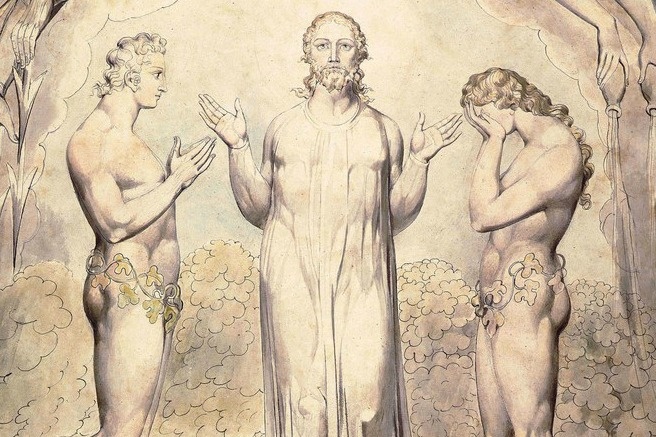Every year in late fall, our local Christian Aid Center has a “Coats for Kids” campaign to help parents outfit their little ones in preparation for the cold of winter. Last year, our Catholic school sponsored a sock drive during the week of St. Nicholas’ feast: a different size each day—from baby booties through toddler, youth, and adult sizes. We learned that, while warm socks are of course one of the most essential kinds of clothing, they are often the last things people think to give.
Clothing the naked was the first work of mercy, performed by God in covering the naked shame of Adam and Eve after the fall (Gen 3:21). Christian poets—Catholic and Protestant—have often pondered this covering over the centuries, finding in it the very essence of the fallen human condition and of Christ’s redemptive power.
In Paradise Lost, John Milton writes movingly of how the nakedness of the first man and woman before the fall signifies their perfect innocence and dignity:
Nor those mysterious parts were then concealed,
Then was not guilty shame, dishonest shame
Of nature’s works . . .
So passed they naked on, nor shunned the sight
Of God or angel, for they thought no ill. (Book 4, lines 312–14, 319–20)
“Dishonest” here means “unchaste”: true chastity, in its unfallen form, knows no shame!
And yet, as soon as they eat of the forbidden fruit, the fallen couple does know shame, and uses their nakedness to explain the fact that they have hidden themselves from their Maker. God the Son, having judged the couple and announced their punishments, proceeds to cover their nudity:
Pitying how they stood
Before him naked to the air, that now
Must suffer change, disdained not to begin
Thenceforth the form of servant to assume,
As when he washed his servants’ feet, so now
As father of his family he clad
Their nakedness . . . (Paradise Lost, Book 10, lines 211–217)
This passage reminds us that, in the 17th century, it was the work of a lowly valet to dress someone; God (in the Person of the Son) thus anticipates his humble washing of the Apostles’ feet when he lowers himself to clothe the nakedness of Adam and Eve. And yet, in doing so, he is also a “father of his family”: a parent who would never leave his children exposed to the elements.
The Son who clothes Adam and Eve in Paradise Lost is the eternal Word of God who has not yet become incarnate as a human being. Another English Renaissance poet, John Donne, writes of the Incarnation itself as the Son’s dressing himself in preparation for the crucifixion:
God clothed himself in vile man’s flesh, that so
He might be weak enough to suffer woe.
And the Jesuit martyr Robert Southwell describes the lowly clothing of Mary and Joseph in the stable of Bethlehem as fitting garb for the retinue of a new kind of King—one who embraces poverty:
Weigh not his mother’s poor attire
Nor Joseph’s simple weed.
This stable is a prince’s court,
This crib his chair of state,
. . .
The persons in that poor attire
His royal liveries wear.
The crucifixion, too, is a clothing of the naked. In Galatians 3:27, St. Paul tells the faithful that, in being baptized, Christians “have clothed [themselves] with Christ.” John Donne thus pleads with God the Father that, when he dies, he will be received by God in Christ’s “purple wrapped” (“Hymn to God, My God, in My Sickness,” line 26). And in his epigram “Upon the Body of Our B[lessed] Lord, Naked and Bloody,” the great Counter-Reformation Catholic poet Richard Crashaw addresses the crucified Jesus, meditating upon his blood as the costliest of robes:
They have left thee naked, Lord, O that they had!
This garment too I would they had denied.
Thee with thyself they have too richly clad;
Opening the purple wardrobe in thy side.
O never could there be garment too good
For thee to wear, but this, of thine own blood.
May every corporal work of mercy, and the clothing of the naked in particular, help to wrap all of us, including the least of Christ’s brothers and sisters, in the royal purple of his sacrifice and the perfect love from which it flows.
Editorial Note: This post originally appeared at FaithND and appears here with the permission of the editor.
![]()
Featured Image: William Blake (1757–1827); The Judgment of Adam and Eve (1808), from Blake’s illustrations of Milton’s Paradise Lost; courtesy of Wikimedia Commons.



